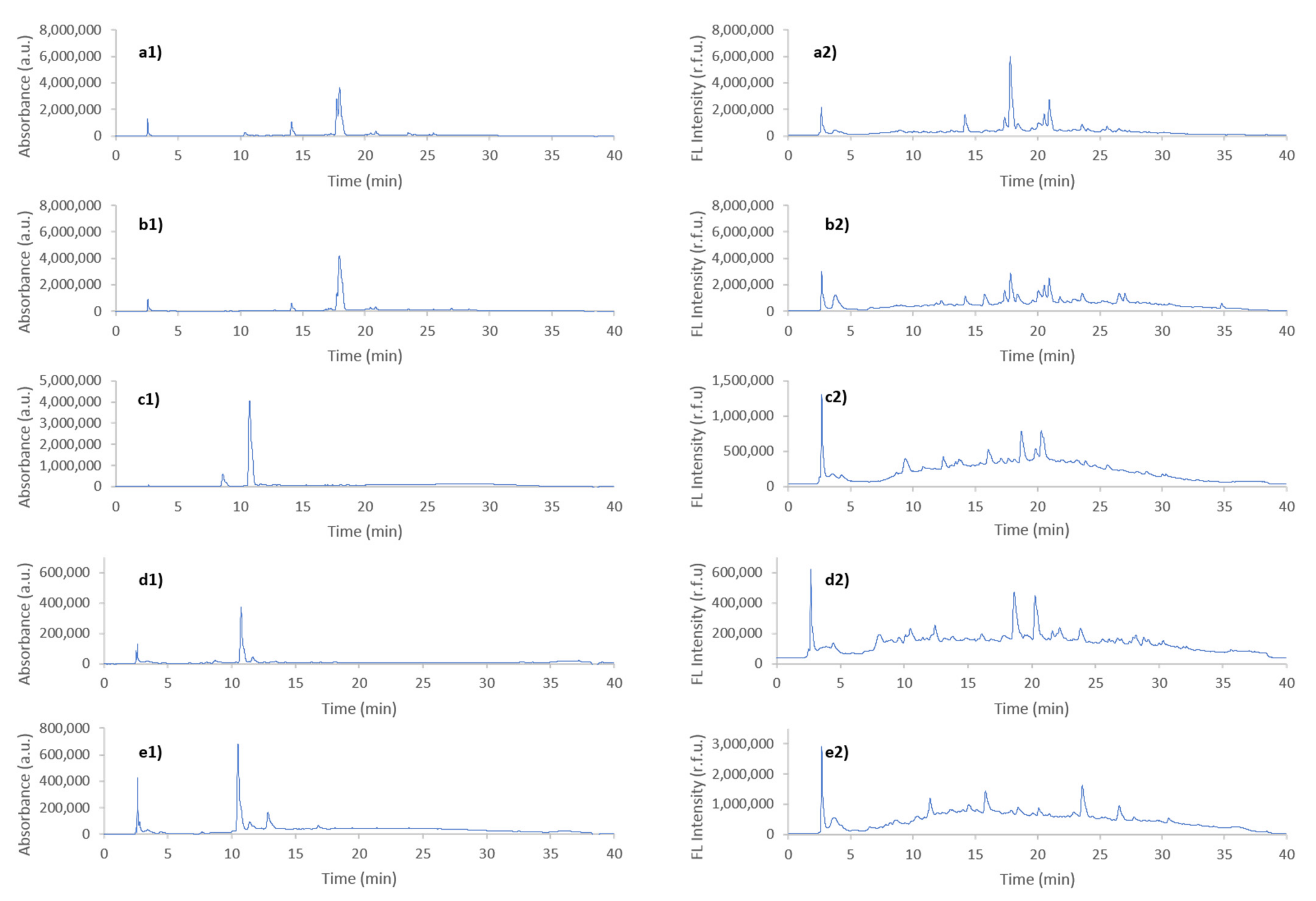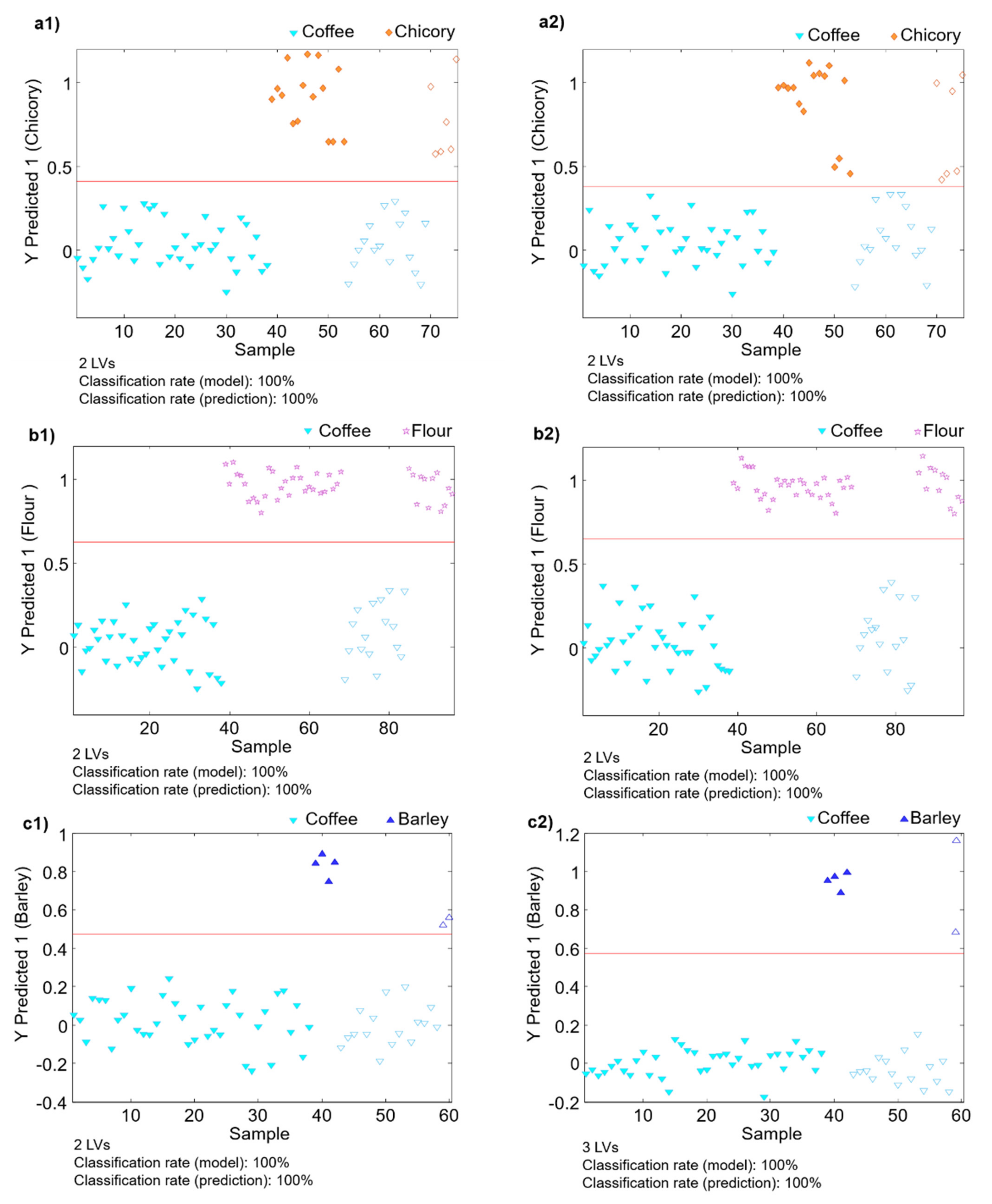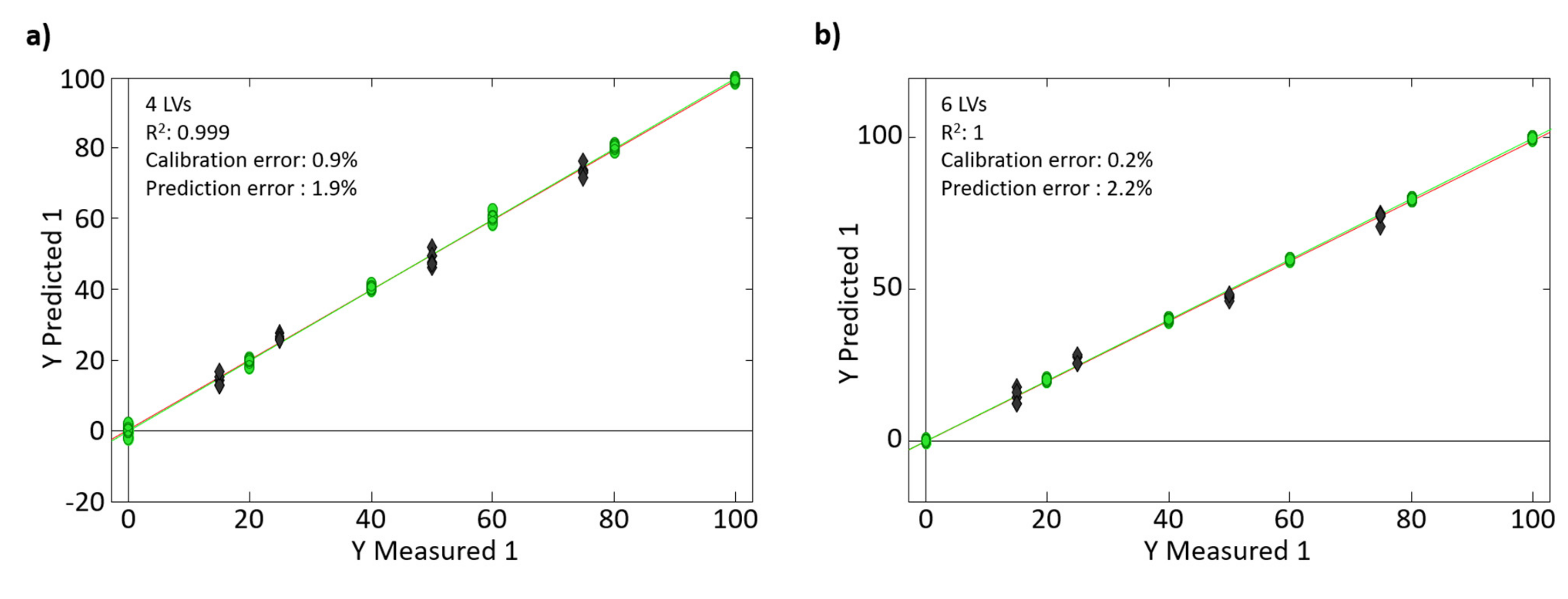Authenticity Assessment and Fraud Quantitation of Coffee Adulterated with Chicory, Barley, and Flours by Untargeted HPLC-UV-FLD Fingerprinting and Chemometrics
Abstract
1. Introduction
2. Materials and Methods
2.1. Reagents and Chemicals
2.2. Instrumentation
2.3. Samples and Sample Extraction Procedure
2.4. Data Analysis
3. Results and Discussion
3.1. Extraction Solvent Optimization
3.2. HPLC-UV and HPLC-FLD Fingerprints
3.3. Sample Characterization and Classification by Chemometrics
3.4. Quantitation of Adulteration Levels by PLS
4. Conclusions
Author Contributions
Funding
Data Availability Statement
Conflicts of Interest
References
- Esquivel, P.; Jiménez, V.M. Functional properties of coffee and coffee by-products. Food Res. Int. 2012, 46, 488–495. [Google Scholar] [CrossRef]
- Naranjo, M.; Vélez, I.L.T.; Benjamín, I.I.; Iii, A.R. Actividad antioxidante de café colombiano de diferentes calidades Antioxidant activity of different grades of Colombian coffee. Rev. Cub. Plant Med. 2011, 16, 164–173. [Google Scholar]
- Thornburn Burns, D.T.; Tweed, L.; Walker, M.J. Ground Roast Coffee: Review of Analytical Strategies to Estimate Geographic Origin, Species Authenticity and Adulteration by Dilution. Food Anal. Methods 2017, 10, 2302–2310. [Google Scholar] [CrossRef]
- Toci, A.T.; Farah, A.; Pezza, H.R.; Pezza, L. Coffee Adulteration: More than Two Decades of Research. Crit. Rev. Anal. Chem. 2015, 46, 83–92. [Google Scholar] [CrossRef] [PubMed]
- Crozier, A.; Ahihara, H.; Tomás-Barbéran, F. (Eds.) Teas, Cocoa and Coffee. Plant Secondary Metabolites and Health; Wiley-Blackwell: Oxford, UK, 2012; ISBN 9781444334418. [Google Scholar]
- Kamiloglu, S. Authenticity and traceability in beverages. Food Chem. 2019, 277, 12–24. [Google Scholar] [CrossRef]
- Sezer, B.; Apaydin, H.; Bilge, G.; Boyaci, I.H. Coffee arabica adulteration: Detection of wheat, corn and chickpea. Food Chem. 2018, 264, 142–148. [Google Scholar] [CrossRef]
- Song, H.Y.; Jang, H.W.; Debnath, T.; Lee, K.-G. Analytical method to detect adulteration of ground roasted coffee. Int. J. Food Sci. Technol. 2018, 54, 256–262. [Google Scholar] [CrossRef]
- Daniel, D.; Lopes, F.S.; dos Santos, V.B.; do Lago, C.L. Detection of coffee adulteration with soybean and corn by capillary electrophoresis-tandem mass spectrometry. Food Chem. 2018, 243, 305–310. [Google Scholar] [CrossRef] [PubMed]
- Campmajó, G.; Núñez, N.; Núñez, O. The Role of Liquid Chromatography-Mass Spectrometry in Food Integrity and Authenticity. In Mass Spectrometry—Future Perceptions and Applications; Kamble, G.S., Ed.; IntechOpen: London, UK, 2019; pp. 3–20. [Google Scholar]
- Moore, J.C.; Spink, J.; Lipp, M. Development and Application of a Database of Food Ingredient Fraud and Economically Motivated Adulteration from 1980 to 2010. J. Food Sci. 2012, 77, R118–R126. [Google Scholar] [CrossRef]
- Gonzalvez, A.; Armenta, S.; Guardia, M. De Trace-element composition and stable-isotope ratio for discrimination of foods with Protected Designation of Origin. Trends Anal. Chem. 2009, 28, 1295–1311. [Google Scholar] [CrossRef]
- De Luca, S.; De Filippis, M.; Bucci, R.; Magrì, A.D.; Magrì, A.L.; Marini, F. Characterization of the effects of different roasting conditions on coffee samples of different geographical origins by HPLC-DAD, NIR and chemometrics. Microchem. J. 2016, 129, 348–361. [Google Scholar] [CrossRef]
- Núñez, N.; Collado, X.; Martínez, C.; Saurina, J.; Núñez, O. Authentication of the Origin, Variety and Roasting Degree of Coffee Samples by Non-Targeted HPLC-UV Fingerprinting and Chemometrics. Application to the Detection and Quantitation of Adulterated Coffee Samples. Foods 2020, 9, 378. [Google Scholar] [CrossRef]
- Núñez, N.; Martínez, C.; Saurina, J.; Núñez, O. High-performance liquid chromatography with fluorescence detection fingerprints as chemical descriptors to authenticate the origin, variety and roasting degree of coffee by multivariate chemometric methods. J. Sci. Food Agric. 2021, 101, 65–73. [Google Scholar] [CrossRef] [PubMed]
- Pérez-Míguez, R.; Sánchez-López, E.; Plaza, M.; Marina, M.L.; Castro-Puyana, M. Capillary electrophoresis-mass spectrometry metabolic fingerprinting of green and roasted coffee. J. Chromatogr. A 2019, 1605, 360353. [Google Scholar] [CrossRef] [PubMed]
- Mehari, B.; Redi-Abshiro, M.; Chandravanshi, B.S.; Combrinck, S.; McCrindle, R.; Atlabachew, M. GC-MS profiling of fatty acids in green coffee ( Coffea arabica L.) beans and chemometric modeling for tracing geographical origins from Ethiopia. J. Sci. Food Agric. 2019, 99, 3811–3823. [Google Scholar] [CrossRef] [PubMed]
- Ongo, E.A.; Montevecchi, G.; Antonelli, A.; Sberveglieri, V.; Sevilla, F. Metabolomics fingerprint of Philippine coffee by SPME-GC-MS for geographical and varietal classification. Food Res. Int. 2020, 134, 109227. [Google Scholar] [CrossRef] [PubMed]
- Danhelova, H.; Hradecky, J.; Prinosilova, S.; Cajka, T.; Riddellova, K.; Vaclavik, L.; Hajslova, J. Rapid analysis of caffeine in various coffee samples employing direct analysis in real-time ionization–high-resolution mass spectrometry. Anal. Bioanal. Chem. 2012, 403, 2883–2889. [Google Scholar] [CrossRef]
- Núñez, N.; Saurina, J.; Núñez, O. Non-targeted HPLC-FLD fingerprinting for the detection and quantitation of adulterated coffee samples by chemometrics. Food Control. 2021, 124, 107912. [Google Scholar] [CrossRef]
- Cai, T.; Ting, H.; Jin-Lan, Z. Novel identification strategy for ground coffee adulteration based on UPLC–HRMS oligosaccharide profiling. Food Chem. 2016, 190, 1046–1049. [Google Scholar] [CrossRef]
- De Morais, T.C.B.; Rodrigues, D.R.; de Carvalho Polari Souto, U.T.; Lemos, S.G. A simple voltammetric electronic tongue for the analysis of coffee adulterations. Food Chem. 2019, 273, 31–38. [Google Scholar] [CrossRef]
- Souto, U.T.D.C.P.; Barbosa, M.F.; Dantas, H.V.; De Pontes, A.S.; Lyra, W.D.S.; Diniz, P.H.G.D.; De Araújo, M.C.U.; Da Silva, E.C. Screening for Coffee Adulteration Using Digital Images and SPA-LDA. Food Anal. Methods 2014, 8, 1515–1521. [Google Scholar] [CrossRef]
- Reis, N.; Botelho, B.G.; Franca, A.S.; Oliveira, L.S. Simultaneous Detection of Multiple Adulterants in Ground Roasted Coffee by ATR-FTIR Spectroscopy and Data Fusion. Food Anal. Methods 2017, 10, 2700–2709. [Google Scholar] [CrossRef]
- Winkler-Moser, J.K.; Singh, M.; Rennick, K.A.; Bakota, E.L.; Jham, G.N.; Liu, S.X.; Vaughn, S.F. Detection of Corn Adulteration in Brazilian Coffee (Coffea arabica) by Tocopherol Profiling and Near-Infrared (NIR) Spectroscopy. J. Agric. Food Chem. 2015, 63, 10662–10668. [Google Scholar] [CrossRef] [PubMed]
- Taghadomi-Saberi, S.; Garcia, S.M.; Masoumi, A.A.; Sadeghi, M.; Marco, S. Classification of Bitter Orange Essential Oils According to Fruit Ripening Stage by Untargeted Chemical Profiling and Machine Learning. Sensors 2018, 18, 1922. [Google Scholar] [CrossRef] [PubMed]
- Beale, D.J.; Morrison, P.D.; Karpe, A.V.; Dunn, M.S. Chemometric Analysis of Lavender Essential Oils Using Targeted and Untargeted GC-MS Acquired Data for the Rapid Identification and Characterization of Oil Quality. Molecules 2017, 22, 1339. [Google Scholar] [CrossRef] [PubMed]
- Barbieri, S.; Cevoli, C.; Bendini, A.; Quintanilla-Casas, B.; García-González, D.L.; Toschi, T.G. Flash Gas Chromatography in Tandem with Chemometrics: A Rapid Screening Tool for Quality Grades of Virgin Olive Oils. Foods 2020, 9, 862. [Google Scholar] [CrossRef]
- Milani, M.I.; Rossini, E.L.; Catelani, T.A.; Pezza, L.; Toci, A.T.; Pezza, H.R. Authentication of roasted and ground coffee samples containing multiple adulterants using NMR and a chemometric approach. Food Control. 2020, 112, 107104. [Google Scholar] [CrossRef]
- Massart, D.L.; Vandeginste, B.G.M.; Buydens, L.M.C.; de Jong, S.; Lewi, P.J.; Smeyers-Verbeke, J. Handbook of Chemometrics and Qualimetrics; Elsevier: Amsterdam, The Netherlands, 1997. [Google Scholar]





| Sample Class | Sample Type | Number of Samples |
|---|---|---|
| Coffee | Vietnamese Arabica coffee | 13 |
| Vietnamese Robusta coffee | 26 | |
| Vietnamese Arabica and Robusta mixture coffee | 9 | |
| Cambodian coffee (Unknown specie) | 6 | |
| Chicory | Chicory | 21 |
| Barley | Barley | 6 |
| Flour | Wheat flour | 7 |
| Rice flour | 4 | |
| Cornmeal flour | 11 | |
| Rye flour | 15 | |
| Oatmeal flour | 5 |
| % of Vietnamese Coffee (Arabica or Robusta) | % of Adulterant (Chicory, Barley, or Wheat Flour) | |
|---|---|---|
| Calibration set | 100 | 0 |
| 80 | 20 | |
| 60 | 40 | |
| 40 | 60 | |
| 20 | 80 | |
| 0 | 100 | |
| Validation set | 85 | 15 |
| 75 | 25 | |
| 50 | 50 | |
| 25 | 75 | |
| 15 | 85 |
| Method | Adulterant | PLS Parameter | Vietnamese Arabica Coffee | Vietnamese Robusta Coffee |
|---|---|---|---|---|
| HPLC-UV fingerprinting | Chicory | LVs | 5 | 4 |
| Calibration error (%) | 0.2 | 0.6 | ||
| Prediction error (%) | 1.2 | 0.9 | ||
| Wheat Flour | LVs | 4 | 4 | |
| Calibration error (%) | 0.9 | 0.4 | ||
| Prediction error (%) | 1.9 | 1.5 | ||
| Barley | LVs | 3 | 3 | |
| Calibration error (%) | 1.4 | 1.0 | ||
| Prediction error (%) | 1.5 | 2.2 | ||
| HPLC-FLD fingerprinting | Chicory | LVs | 4 | 3 |
| Calibration error (%) | 0.5 | 0.9 | ||
| Prediction error (%) | 1.1 | 2.0 | ||
| Wheat Flour | LVs | 6 | 4 | |
| Calibration error (%) | 0.2 | 0.3 | ||
| Prediction error (%) | 2.2 | 1.0 | ||
| Barley | LVs | 4 | 6 | |
| Calibration error (%) | 0.4 | 1.3 | ||
| Prediction error (%) | 0.4 | 2.4 |
Publisher’s Note: MDPI stays neutral with regard to jurisdictional claims in published maps and institutional affiliations. |
© 2021 by the authors. Licensee MDPI, Basel, Switzerland. This article is an open access article distributed under the terms and conditions of the Creative Commons Attribution (CC BY) license (https://creativecommons.org/licenses/by/4.0/).
Share and Cite
Núñez, N.; Saurina, J.; Núñez, O. Authenticity Assessment and Fraud Quantitation of Coffee Adulterated with Chicory, Barley, and Flours by Untargeted HPLC-UV-FLD Fingerprinting and Chemometrics. Foods 2021, 10, 840. https://doi.org/10.3390/foods10040840
Núñez N, Saurina J, Núñez O. Authenticity Assessment and Fraud Quantitation of Coffee Adulterated with Chicory, Barley, and Flours by Untargeted HPLC-UV-FLD Fingerprinting and Chemometrics. Foods. 2021; 10(4):840. https://doi.org/10.3390/foods10040840
Chicago/Turabian StyleNúñez, Nerea, Javier Saurina, and Oscar Núñez. 2021. "Authenticity Assessment and Fraud Quantitation of Coffee Adulterated with Chicory, Barley, and Flours by Untargeted HPLC-UV-FLD Fingerprinting and Chemometrics" Foods 10, no. 4: 840. https://doi.org/10.3390/foods10040840
APA StyleNúñez, N., Saurina, J., & Núñez, O. (2021). Authenticity Assessment and Fraud Quantitation of Coffee Adulterated with Chicory, Barley, and Flours by Untargeted HPLC-UV-FLD Fingerprinting and Chemometrics. Foods, 10(4), 840. https://doi.org/10.3390/foods10040840








